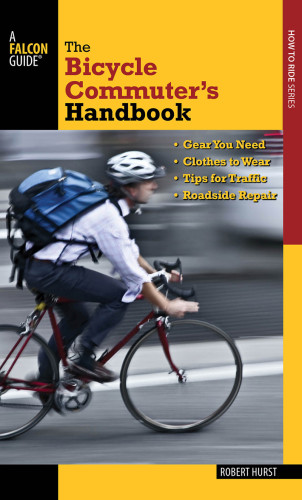The Bicycle Commuter’s Handbook is the 4th book by Robert Hurst that I have reviewed for Cycling Utah. You may be thinking that Mr. Hurst is using me as a conduit to promote his books. Actually I really like what Mr. Hurst has to say in his books about bicycle commuting. Like his previous books, The Bicycle Commuter’s Handbook is also very good for the beginning bicycle commuter or perhaps the commuter that is planning to get rid of a car and ramp up the miles on their commuter bike. I will to clarify that The Bicycle Commuter’s Handbook is a larger and much more detailed version of Mr. Hurst’s previous book specific to bike commuting, The Bicycle Commuter’s Pocket Guide.
I will paraphrase the “About the Author” citation by Falcon Guides. “Robert Hurst is acknowledged by most experts to be the most complete, realistic, and readable source available for information and tips about cycling in traffic”. Given my decades of bike commuting I will humbly place myself in the “expert” category, as vague as expert is defined, and concur with the opinion. Mr. Hurst’s books update to the current time previous books on bicycle commuting by John Allen (The complete book of Bicycle Commuting; 1981) and John Forrester’s Effective Cycling, first published in 1976.
The Bicycle Commuter’s Handbook is just that, a handbook measuring 4 X 7 inches containing 90 pages. If one is interested in a more complete book on the subject of bike travel, I would suggest The Art of Cycling, also by Robert Hurst. The Bicycle Commuter’s Handbook is more of a “nuts and bolts” type of book. For example, he spends 8 pages briefly discussing the types of bikes with their inherent pros and cons from mountain bikes to cruisers to bike sharing programs. He doesn’t give any detail on what he would call an ideal commuter bike but that is not the intent. The 8 pages are quite informative for someone looking to see if the bike he (or she) owns is suitable for commuting.
Part III of the book is particularly good. It is entitled “The Ride”, giving a general overview of how to ride your bike safely, a section that many bike commuters, should read. Part Five will be interesting to most cycle commuters as it discusses the basic routine maintenance. It is limited to adjusting the drivetrain and brakes plus the prevention and repair of flat tires. After reading the 9 pages, including pictures, of the step-by-step instructional guide for flat repair, you should never have to use your phone to call for help. Mr. Hurst also addresses the age old dilemma, is it cheaper to routinely replace the chain to prevent excess wear on the rear cogs and chainrings or should one just ride until the entire drivetrain needs replacing. So I don’t give away too much, you can read it in the book or send an email to me Lou@Cyclingutah.com for his analysis. I should note that Parts I, II, and IV are also very good, probably more useful to the beginning commuter than the bike commuter with years of experience.
So you now have 3 bicycle commuter books to choose from written by Mr. Hurst, the comprehensive and recently updated The Art of Cycling; Staying Safe on City Streets; the fit in your pocket The Bicycle Commuter’s Pocket Guide, and the new The Bicycle Commuter’s Handbook. The pocket guide would make a great stocking stuffer or small gift to a friend considering commuting but for $3 more, The Bicycle Commuter Handbook would be a better offering. The Art of Cycling should be read by anyone that rides the streets.
The Bicycle Commuter’s Handbook
By: Robert Hurst
2013
A Falcon Guide by Morris Book Publishing
ISBN-10: 0762784687








